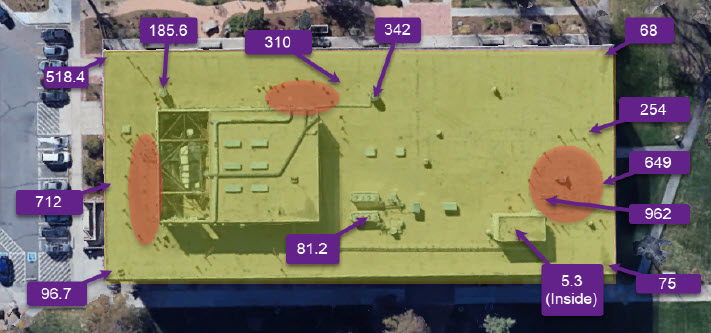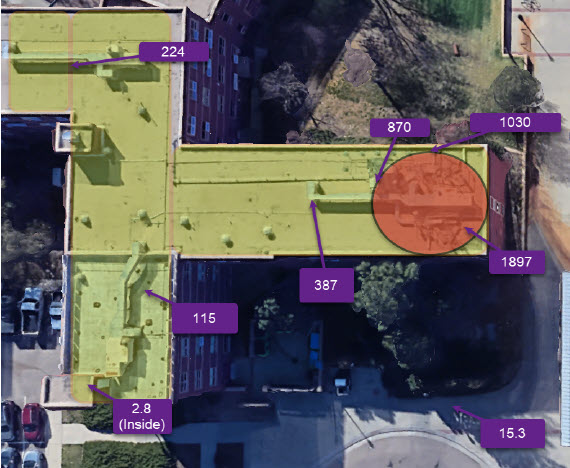Rooftop Safety
- Purpose and Scope
This program is intended for any team on campus that may need to access the rooftop at Robson Arena. Due to steep pitch and potentially slick surfaces, access for individuals to this space must meet the requirements of the program as listed below.
- References
- OSHA 1910.140: Personal Fall Protection Systems (https://www.osha.gov/laws-regs/regulations/standardnumber/1910/1910.140)
- OSHA 1910.28: Duty to have fall protection and falling object protection (https://www.osha.gov/laws-regs/regulations/standardnumber/1910/1910.28)
- Definitions
- Responsibilities
- Environmental Health and Safety Department
- Review and update the program to conform with current regulations and initiatives
- Monitor compliance with standards set forth in the program by periodic inspections and work planning.
- Ensure all person with the propensity for access are enrolled and complete training
- Provide guidance for the access to the rooftop spaces
- Supervisors / Managers
- Ensure that all employees perform their assigned duties as outlined in this program.
- Ensure employees are trained for the tasks assigned to them (i.e. qualified person).
- Ensure employees are provided with and use appropriate protective equipment.
- Employees
- Follow the work practices described in this document.
- Attend all training required
- Immediately report any concerns to supervisors
- Environmental Health and Safety Department
- Training
- Any Colorado College (CC) Employee, who in the line of their work responsibilities, are required to access the rooftop at Robson Arena must be trained on this procedure and on the following topics by a “qualified person”:
- Fall Protection as detailed in OSHA 1910.140
- Proper use of and inspection of a harness
- Proper use of tie-off devices and safety equipment
- Training must be provided and completed prior to the employee(s) being assigned duties that would require access to this space.
- A “qualified person” shall be trained and knowledgeable in the following topics
- OSHA 1910.140: Personal Fall Arrest Systems
- OSHA 1910.140: Duty to have fall protection and falling object protection
- Inspection and proper donning and doffing harnesses
- Proper tie-off techniques to be used with safety equipment installedRooftop Access
- Personnel accessing rooftops must notify the Environmental Health and Safety Department prior to commencing work.
- EHS will verify that the training requirements have been met by all CC employees requesting to access the space.
Contractors are expected to be knowledgeable of pertinent OSHA regulations and to follow the guidance provided by the aforementioned OSHA regulations.
- Once determination is made that access will be needed, coordination with the Environmental Health and Safety department shall occur for accessing parties with the following information being required:
- Date of access
- Time (duration) of access
- Work being completed
- The following rules must be followed by all persons accessing the space
- 5-point harness must be worn
- 2-man entry teams must be followed
- Access will not be permitted in foul weather where precipitation is a factor including but not limited to: rain, sleet, snow., hail, dew, condensation.
- The Environmental Health and Safety team shall review the safety devices present with accessing parties.
- Upon the requirements having been met access will be given to the interested party with a check-out of the key for the rooftop hatch.
- Upon completion of the task(s) the key shall be checked back in with the Environmental Health and Safety Department.
- Purpose and Scope
This program is intended for any team on campus that may need to access rooftop areas that are equipped with Cellular Transmission Towers. As radio frequencies in high enough amplitude can cause harm to persons, these requirements are to be followed by anyone needing to access these spaces in the line of work.
- References
- BioInitiative 2012 (https://bioinitiative.org/search/2007+report/)
- Ionizing and Non-Ionizing Radiation Safety (360training.com)
- OSHA 1910.97 – Nonionizing Radiation
- Radio Frequency Safety (https://www.fcc.gov/general/radio-frequency-safety-0)
- Attachments
- Map: Rooftop – Armstrong Hall
- Map: Rooftop – Worner Center
- Map: Rooftop – Loomis Hall
- Definitions
- RF – Radio Frequency
- Ionizing Radiation – X-ray and Gamma Ray emitting devices
- mW/m2 – Megawatt per square meter (unit of measure of RF levels)
- Responsibilities
- Environmental Health and Safety Department
- Review and update the program to conform with current regulations and initiatives involving Cellular Transmission Towers.
- Monitor compliance with standards set forth in the program by periodic inspections and work planning.
- Ensure all person with the propensity for access are enrolled and complete training
- Provide guidance for the access to the rooftop spaces
- Supervisors / Managers
- Ensure that all employees perform their assigned duties as outlined in this program.
- Ensure employees are trained for the tasks assigned to them (i.e. qualified person).
- Ensure employees are provided with and use appropriate protective equipment.
- Employees
- Follow the work practices described in this document.
- Attend all training required
- Immediately report any concerns to supervisors
- Environmental Health and Safety Department
Training
- Any Colorado College (CC) Employee, who in the line of their work responsibilities, are required to access rooftops with Cellular Transmission Towers (CTT) must be trained on this procedure.
- Training must be provided and completed prior to the employee(s) being assigned duties that would require access to these spaces.
- A “qualified person” shall be trained and knowledgeable in the following topics
- Radiation including kinds of radiation found in the workplace
- Effects of radiation on human health
- Preventative measures that area applied to control radiation in the work areas.
- Time
- Personnel can minimize their time of contact with radiation to reduce the amount of radiation absorbed into their bodies
- A Time Weighted Average methodology can help to limit a person’s exposure to the radiation potentially absorbed into their bodies
- Colorado College shall limit the time of exposure on the rooftops depending on readings acquired during the survey as follows
- If reading levels were between 10 mW/m2 and 100 mW/m2 a person is permitted to work up to 6 hours in the space.
- If reading levels were between 100 mW/m2 and 500 mW/m2 a person may be permitted to work, no more than 30 minutes/hr each hour.
(Example: employee enters zone at 1:00PM, they must leave the area at 1:30PM and remain off the rooftop for at least 30 minutes before re-entering the space. In any given 8-hour period the employe shall not have exposure that exceed a cumulative of 4 hours)
- If reading levels are > 500 mW/m2 a person may be permitted to work no more than 15 minutes/hr each hour
(Example: employee enters zone at 1:00PM, they are required to leave the area at 1:15PM and remain off the rooftop for at least 45 minutes before re-entering the space. In any given 8-hour period the employee shall not have exposure that exceed a cumulative of 2 hours)
- Building Envelope (Shielding)
- RF Radiation is greatly reduced by building envelopes (e/g – brick, stucco, roofing materials, metal decking, etc.)
- Work being performed in concealed spaces (e.g. – penthouse on Armstrong) can continue without the time restrictions listed in Section 8.1
- Work performed at ground level can continue without time restriction listed in Section 8.1
- Administrative Controls
- Warning signs shall be posted in all areas, rooms, or entrances to spaces where RF Radiation fields may be present.
- Information about the type of radiation and the extent of the hazard must be mentioned.
- Radiation producing devices should be labeled by the Cellular provider
- Barricades must be installed to limit a person’s ability to be too close to emitting devices
- Rooftop Access
- Personnel accessing rooftops must notify the Environmental Health and Safety Department prior to commencing work.
- Tasks must be completed within the amount of time listed in Section 8.1, work planning may need to be discussed to ensure that the exposure limits are followed stringently. Tasks should be grouped if possible (e.g. – multiple PM’s occurring on rooftop should be completed together, not spread out over time)
- If possible, rooftop antennas should be powered down to allow for work to be completed.
- To power down the antennas:
- Contact the EHS Department and schedule the times that the antennas will need to be turned off.
- Notification to the Cellular Providers should be submitted 48-72 hours in advance
- Follow – up / day of notification should be made 2 hours prior to work commencing.
- EHS will accompany the team to rooftop(s) to verify the antennas have been powered down.
- To power down the antennas:
Note: If antennas are not powered down as needed, a plan as outlined below in 6.3.2 will need to be devised to proceed with work.
- If work is to be done with active antennas:
- Coordination of work to be done and timeline to limit exposure as specified in Section 8.1.
- EHS will require a Job breakdown along with the names of the personnel that are to access the space(s).
- Work will commence on required intervals
- EHS will audit work progression
- To power up antennas
- EHS will verify work completion with team(s)
- EHS will contact needed providers to notify of work completion and ability to power back on antennas.
Map: Rooftop – Armstong Hall
Red Circles = 15 minute exposure
Yellow Shading = 30 minute exposure

Map: Rooftop – Worner Center
Red Circles = 15 minute exposure
Yellow Shading = 30 minute exposure

Map: Rooftop – Loomis Hall
Red Circles = 15 minute exposure
Yellow Shading = 30 minute exposure

show all / hide all


